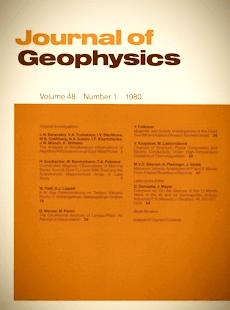The solution of dynamic problems of elastic wave propagation in inhomogeneous media by a combination of partial separation of variables and finite-difference methods
Article Sidebar
Published:
Mar 27, 1980
Keywords:
Theoretical seismograms,
Finite differences,
Partial separation of variables,
Non-ray effects,
Finite integral transforms
Volumes

Vols. 1-18 (1924-1944), ISSN 0044-2801
Main Article Content
A.S. Alekseev
Computing Center, Siberian Branch, Russian Academy of Sciences, Novosibirsk Russia
B.G. Mikhailenko
Computing Center, Siberian Branch, Russian Academy of Sciences, Novosibirsk Russia
Abstract
A new method for the calculation of theoretical seismograms, which is suitable for a wide class of inhomogeneous media, is suggested. The method is based on a combination of partial separation of variables with finite-difference techniques. Different variants of the method, based on the application of the Fourier-Bessel transform, finite integral transforms, expansions in Legendre polynomials, etc., are discussed in detail. Examples of theoretical seismograms for various simple structures are presented.
 ARK: https://n2t.net/ark:/88439/y045452
ARK: https://n2t.net/ark:/88439/y045452
Permalink: https://geophysicsjournal.com/article/79
Article Details
How to Cite
Alekseev, A., & Mikhailenko, B. (1980). The solution of dynamic problems of elastic wave propagation in inhomogeneous media by a combination of partial separation of variables and finite-difference methods. Journal of Geophysics, 48(1), 161-172. Retrieved from https://journal.geophysicsjournal.com/JofG/article/view/79
Section
References
Alekseev, A.S., Mikhailenko, B.G. (1976) The solution of Lamb's problem for a vertically inhomogeneous elastic half-space. Izv. Akad. Nauk SSSR, Fiz. Zemli 12:11-25
Alekseev, A.S., Mikhailenko, B.G. (1977) Numerical modelling of seismic waves propagating in a radially inhomogeneous Earth's model. Dokl. Akad. Nauk SSSR 235:46-49
Alekseev, A.S., Mikhailenko, B.G. (1978) The method of calculation of theoretical seismograms for complex media models. Dokl. Akad. Nauk SSSR 240:1062-1065
Alterman, Z., Karal, F.C. (1968) Propagation of elastic waves in layered media by finite difference methods. Bull. Seismol. Soc. Am. 58:367-398
Červeny, V., Molotkov, I.A., Pšenčik, I. (1977) Ray method in seismology. Univerzita Karlova, Praha
Koshlyakov, N.S., Gliner, E.B., Smirnov, M.M. (1970) Partial differential equations of mathematical physics. Moscow: Vysshaya shkola
Mikhailenko, B.G. (1973) Numerical solution of Lamb's problem for inhomogeneous half-space. In: Lavrentiev, M.M., Alekseev, A.S. (eds.) Mathematical problems of geophysics, Novosibirsk: Computing Center Acad. Sci. USSR (Sib. Division), 4:273-297
Mikhailenko, B.G. (1974) Numerical simulation of elastic wave propagation in the thin layer. In: Lavrentiev, M.M., Alekseev, A.S. (eds.) Mathematical problems of geophysics, Novosibirsk: Computing Center Acad. Sci. USSR (Sib. Division), 5(1):187-194
Mikhailenko, B.G. (1978) Calculation of theoretical seismograms for multi-dimensional medium models. In: Uslovno-korrektnye zadachi matematicheskoy fiziki v interpretatsii geofizicheskikh nablyudenii. Izd. VTs SO AN USSR
Mikhailenko, B.G. (1979) The method of solution of dynamic seismic problems for two-dimensional inhomogeneous media models. Dokl. Acad. Nauk USSR 246, 47-51
Sneddon, I. (1951) Fourier transforms. New York, Toronto, London
Alekseev, A.S., Mikhailenko, B.G. (1977) Numerical modelling of seismic waves propagating in a radially inhomogeneous Earth's model. Dokl. Akad. Nauk SSSR 235:46-49
Alekseev, A.S., Mikhailenko, B.G. (1978) The method of calculation of theoretical seismograms for complex media models. Dokl. Akad. Nauk SSSR 240:1062-1065
Alterman, Z., Karal, F.C. (1968) Propagation of elastic waves in layered media by finite difference methods. Bull. Seismol. Soc. Am. 58:367-398
Červeny, V., Molotkov, I.A., Pšenčik, I. (1977) Ray method in seismology. Univerzita Karlova, Praha
Koshlyakov, N.S., Gliner, E.B., Smirnov, M.M. (1970) Partial differential equations of mathematical physics. Moscow: Vysshaya shkola
Mikhailenko, B.G. (1973) Numerical solution of Lamb's problem for inhomogeneous half-space. In: Lavrentiev, M.M., Alekseev, A.S. (eds.) Mathematical problems of geophysics, Novosibirsk: Computing Center Acad. Sci. USSR (Sib. Division), 4:273-297
Mikhailenko, B.G. (1974) Numerical simulation of elastic wave propagation in the thin layer. In: Lavrentiev, M.M., Alekseev, A.S. (eds.) Mathematical problems of geophysics, Novosibirsk: Computing Center Acad. Sci. USSR (Sib. Division), 5(1):187-194
Mikhailenko, B.G. (1978) Calculation of theoretical seismograms for multi-dimensional medium models. In: Uslovno-korrektnye zadachi matematicheskoy fiziki v interpretatsii geofizicheskikh nablyudenii. Izd. VTs SO AN USSR
Mikhailenko, B.G. (1979) The method of solution of dynamic seismic problems for two-dimensional inhomogeneous media models. Dokl. Acad. Nauk USSR 246, 47-51
Sneddon, I. (1951) Fourier transforms. New York, Toronto, London











